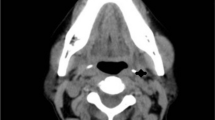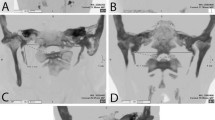Abstract
Styloid process is a long and slender osseous projection protruding downward, forward and slightly medially from the temporal bone and serves as an anchor point for various muscles associated with the tongue and the larynx. The aim of the present study was to record the length and the angle of Styloid process on three dimensional computed tomography in patients with unilateral symptomatic and palpable styloid process and compare the length and the angle of styloid process of symptomatic side to asymptomatic side on three dimensional computed tomography. 3D-CT face reconstruction were perfomed in all 35 patients (17 females, 18 males of age range 25–69 years). The length of the styloid process and its angulation (transverse and sagittal angles) were measured by means of three dimensional and multiplanar reconstruction images. The length of styloid process on symptomatic side had a mean of 33.61 ± 5.08 mm while on asymptomatic side mean was 31.11 ± 5.02 mm. The mean transverse angle on symptomatic sides had a mean of 72.37° ± 4.48° while on asymptomatic side mean was 74.17° ± 4.48°. The mean sagittal angle seen on symptomatic side was 88.11° ± 5.21° while on asymptomatic side was 87.88° ± 5.03°. Symptomatic side has a longer styloid. Length of the styloid process has a statistical correlation with the symptoms and symptomatic side has a longer styloid. Though there was a difference in transverse and sagittal angulation in symptomatic versus asymptomatic side; but it was not statistically significant. On examination of the opposite asymptomatic side, 5 patients had a palpable styloid process therefore we infer that long styloid process may not always be associated with symptoms. Patients with cervicofacial pain should be evaluated for Eagle syndrome by palpation of styloid process in the tonsillar fossa and further by three dimensional computed tomography (3D-CT). 3D CT is an effective tool in evaluating patients with cervicofacial pain and making a diagnosis of Eagle’s syndrome. Therefore, 3D CT should be performed while evaluating patients with these symptoms.



Similar content being viewed by others
References
Eagle WW (1937) Elongated styloid process. Report of two cases. Arch Otolaryngol 25:584–587
Kusunoki T, Homma H, Kidokoro Y, Yanai A, Fujimaki M, Ikeda K et al (2016) A case of a very elongated styloid process 8 cm in length with frequent throat pain for 10 years. Clin Pract 6:820
Custodio AL, Silva MR, Abreu MH, Araújo LR, de Oliveira LJ (2016) Styloid process of the temporal bone: morphometric analysis and clinical implications. Biomed Res Int 2016:879–895
Eagle W (1948) Elongated styloid process: further observations and new syndrome. Arch Otolaryngol 47:630–640
Piagkou M, Anagnostopoulou S, Kouladouros K, Piagkos G (2009) Eagle’s syndrome: a review of the literature. Clin Anat 22:545–558
Sharma N, Ram R, Kamal R (2016) Unusually elongated styloid process: a report of two cases with literature review. Ann Maxillofac Surg 6:297–299
Sridevi K, Mahesh N, Krishnaveni B, Deepika ADN, Thejasri V, Leninson BHD (2019) Evaluation of styloid process and its anatomical variations: a digital panoramic study with systematic review. J Int Soc Prev Commun Dent 9:256–262
Ilguy M, Ilguy D, Güler N, Bayirli G (2005) Incidence of the type and calcification patterns in patients with elongated styloid process. J Int Med Res 33:96–102
Keur JJ, Campbell JP, McCarthy JF, Ralph WJ (1986) The clinical significance of the elongated styloid process. Oral Surg Oral Med Oral Pathol 61:399–404
Gossman JR Jr, Tarsitano JJ (1977) The styloid-stylohyoid syndrome. J Oral Surg 35:555–560
Ferrario VF, Sigurta D, Daddona A et al (1990) Calcification of the stylohyoid ligament: incidence and morphoquantitative evaluations. Oral Surg Oral Med Oral Pathol 69:524–529
More CB, Aarani MK (2010) Evaluation of the styloid process on digital panoramic radiograph. Indian J Radiol Imaging 20:261–265
Montalbetti L, Ferrandi D, Pergami P, Savoldi F (1995) Elongated styloid process and Eagle’s syndrome. Cephalalgia 15:80–93
Onbas O, Kantarci M, Murat Karasen R, Durur I, Cinar Basekim C, Alper F, Okur A (2005) Angulation, length, and morphology of the styloid process of the temporal bone analyzed by multidetector computed tomography. Acta Radiol 46:881–886
Palesy P, Murray GM, De Boever J, Klineberg I (2000) The involvement of the styloid process in head and neck pain: a preliminary study. J Oral Rehabil 27:275–287
Murthy PS, Hazarika P, Mathai M, Kumar A, Kamath MP (1990) Elongated styloid process: an overview. Int J Oral Maxillofac Surg 19:230–231
Strauss M, Zohar Y, Laurian N (1985) Elongated styloid process syndrome: intraoral versus external approach for styloid surgery. Laryngoscope 95:976–979
Kaufman SM, Elzay RP, Irish EF (1970) Styloid process variation. Radiol Clin Study Arch Otolaryngol 91:460–463
Balcioglu HA, Kilic C, Akyol M, Ozan H, Kokten G (2009) Length of the styloid process and anatomical implications for Eagle’s syndrome. Folia Morphol 68:265–270
Ceylan A, Köybaşioğlu A, Çelenk F, Yilmaz O, Uslu S (2008) Surgical treatment of elongated styloid process: experience of 61 cases. Skull Base 18:289
Basekim CC et al (2005) Evaluation of styloid process by three-dimensional computed tomography. Eur Radiol 15:134–139
Shayganfar A, Golbidi D, Yahay M, Nouri S, Sirus S (2018) Radiological evaluation of the styloid process length using 64-row multidetector computed tomography scan. Adv Biomed Res 7:85
Author information
Authors and Affiliations
Corresponding author
Ethics declarations
Conflict of interest
Authors declare that they have no conflicts of interest.
Ethical Approval
This article does not contain any studies which experiments with human participants or animals and all institutional and international ethical standards have been followed.
Informed Consent
Informed consent was obtained from all individuals participants included in the study.
Additional information
Publisher's Note
Springer Nature remains neutral with regard to jurisdictional claims in published maps and institutional affiliations.
Rights and permissions
About this article
Cite this article
Singh, R., Sharma, R., Sharma, V.K. et al. Styloid Process; Correlation Between Symptoms, Palpability and Measurements on Three Dimensional Computed Tomography. Indian J Otolaryngol Head Neck Surg 74 (Suppl 3), 5556–5561 (2022). https://doi.org/10.1007/s12070-021-02901-5
Received:
Accepted:
Published:
Issue Date:
DOI: https://doi.org/10.1007/s12070-021-02901-5




